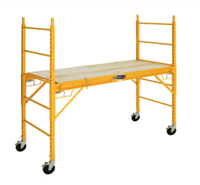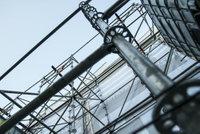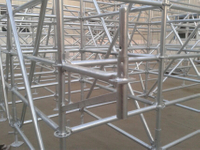Content Menu
● Key Cuplock Scaffolding Components
>> 1. Standards (Verticals)
>> 2. Ledgers (Horizontals)
>> 3. Diagonal Braces
>> 4. Base Jacks
>> 5. Decking (Planks/Platforms)
>> 6. Toe Boards
>> 7. Spigots (Joint Pins)
>> 8. Guardrails
>> 9. Intermediate Transoms
● Benefits of Understanding Cuplock Scaffolding Components
● Common Mistakes with Cuplock Scaffolding Components
● Applications of Cuplock Scaffolding Components
● Conclusion
● FAQ
>> 1. What are the most important Cuplock scaffolding components?
>> 2. What materials are used for Cuplock scaffolding components?
>> 3. How do diagonal braces improve scaffold stability?
>> 4. Can Cuplock scaffolding be customized for specific projects?
>> 5. How often should Cuplock scaffolding components be inspected?
● Citations:
Cuplock scaffolding is a modular scaffolding system widely used in construction for its efficiency, safety, and versatility. Its unique locking mechanism and prefabricated components make it easy to assemble, disassemble, and adapt to various project requirements. Understanding the essential components of Cuplock scaffolding is crucial for ensuring its proper use and maximizing its benefits. This article provides an in-depth overview of the key Cuplock scaffolding components, their functions, and their importance in modern construction.
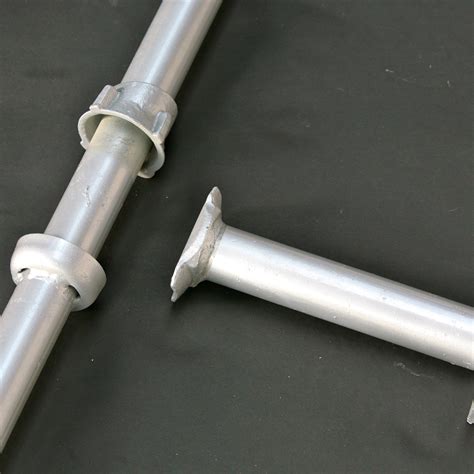
Key Cuplock Scaffolding Components
Cuplock scaffolding consists of several essential components that work together to create a stable and reliable structure. Below is a detailed explanation of these components:
1. Standards (Verticals)
- Description: Standards are the vertical tubes that form the primary load-bearing structure of the scaffolding system.
Features:
- Equipped with fixed bottom cups at regular intervals (typically every 500mm).
- Rotating top cups secure up to four horizontal components at a single joint.
- Made from high-tensile steel for durability.
- Function: Provide vertical support and serve as the backbone of the scaffold.
- Sizes: Common sizes include 0.5m, 1.0m, 1.5m, 2.0m, and 3.0m.
2. Ledgers (Horizontals)
- Description: Ledgers are horizontal tubes that connect the standards, providing lateral support.
Features:
- Fitted with forged ledger blades at both ends for easy connection to standards.
- Made from galvanized steel for corrosion resistance.
- Function: Stabilize the structure and support platforms or decking.
- Applications: Can also be used as guardrails in staircase towers.
3. Diagonal Braces
- Description: Bracing tubes that are connected diagonally between standards and ledgers.
Features:
- Enhance stability by resisting lateral forces.
- Available with swivel clamps or blades for secure attachment.
- Function: Prevent swaying or tipping of the scaffold under load.
4. Base Jacks
- Description: Adjustable base plates placed at the bottom of standards to level the scaffold on uneven ground.
Features:
- Includes a threaded stem for height adjustment.
- Can accommodate base plates or spigots for added stability.
- Function: Distribute weight evenly and ensure a stable foundation.
5. Decking (Planks/Platforms)
- Description: Steel or aluminum planks placed horizontally on ledgers to create working platforms.
Features:
- Available in galvanized or powder-coated finishes for durability.
- Designed with hooks for secure placement on ledgers.
- Function: Provide a safe working surface for construction tasks.
6. Toe Boards
- Description: Boards installed along platform edges to prevent tools or materials from falling off.
Features:
- Made from steel or wood.
- Easily attachable to ledgers or planks.
- Function: Enhance safety by containing loose items on platforms.
7. Spigots (Joint Pins)
- Description: Pins used to connect vertical standards when extending scaffold height.
Features:
- Made from high-strength steel for load-bearing capacity.
- Include locking mechanisms to prevent accidental disconnection.
- Function: Enable vertical extension of scaffolds.
8. Guardrails
- Description: Horizontal bars installed at platform edges to prevent falls.
Features:
- Easily attachable to standards using cups or clamps.
- Made from lightweight yet durable materials like aluminum or steel.
- Function: Protect workers from falling off elevated platforms.
9. Intermediate Transoms
- Description: Horizontal tubes placed between ledgers to provide additional support for planks.
Features:
- Designed to fit securely into the scaffold framework.
- Available in various lengths based on platform width requirements.
- Function: Enhance platform stability by reducing deflection.
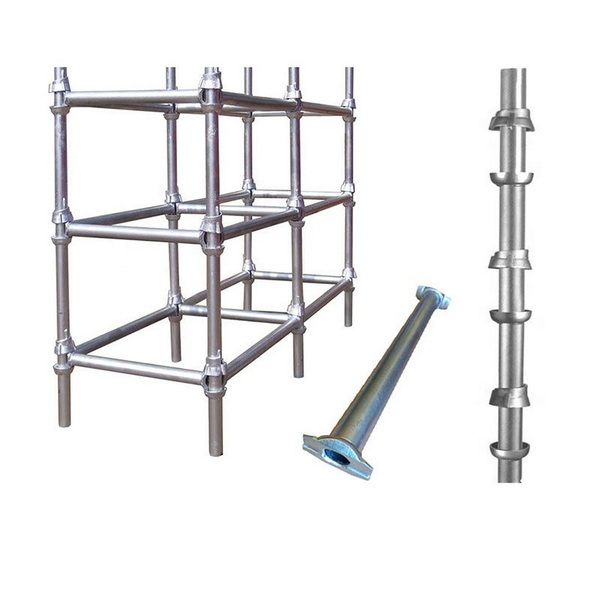
Benefits of Understanding Cuplock Scaffolding Components
1. Improved Safety:
- Knowing how each component functions ensures proper assembly and reduces risks of structural failure.
2. Efficient Assembly:
- Familiarity with components speeds up erection and disassembly processes.
3. Cost Savings:
- Proper use minimizes wear and tear, extending the lifespan of components.
4. Versatility in Applications:
- Understanding component configurations allows customization for various project needs, such as facade scaffolding, formwork support, or mobile towers.
Common Mistakes with Cuplock Scaffolding Components
1. Incorrect Assembly of Standards and Ledgers:
- Misaligned connections can compromise stability.
2. Overloading Platforms:
- Exceeding load limits can lead to structural collapse.
3. Omitting Safety Features like Guardrails or Toe Boards:
- Increases risks of falls or injuries.
4. Neglecting Regular Inspections:
- Failure to check components for damage can result in accidents during use.
Applications of Cuplock Scaffolding Components
Cuplock scaffolding components are versatile and can be used in a wide range of construction scenarios:
1. Facade Scaffolding: Provides access for painting, cleaning, or repairs on building exteriors.
2. Formwork Support: Supports concrete slabs during pouring and setting processes.
3. Staircase Towers: Creates safe access routes between different levels of a structure.
4. Mobile Towers: Used in maintenance tasks requiring frequent repositioning of scaffolds.
5. Circular Scaffolds: Adapts easily to curved structures like silos or chimneys.
Conclusion
Understanding the essential Cuplock scaffolding components is critical for safe and efficient use in construction projects. From standards and ledgers to diagonal braces and decking, each component plays a vital role in creating a stable structure that meets project requirements while ensuring worker safety. By familiarizing yourself with these components and their functions, you can optimize scaffold performance, reduce risks, and achieve better results in your construction endeavors.
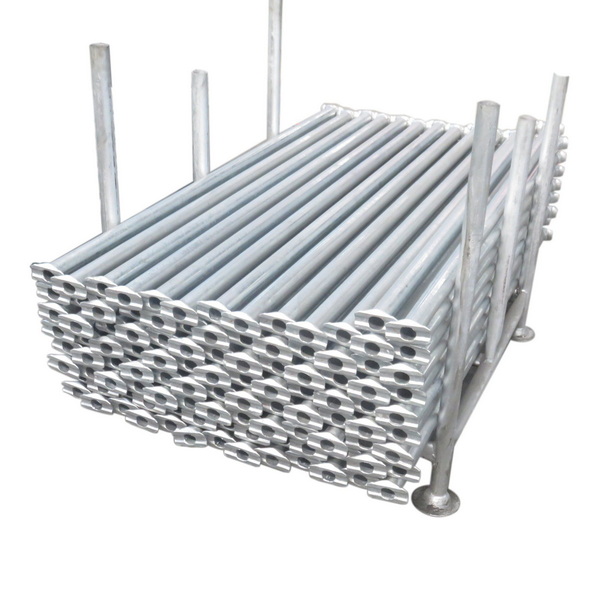
FAQ
1. What are the most important Cuplock scaffolding components?
The key components include standards (verticals), ledgers (horizontals), diagonal braces, base jacks, decking (platforms), toe boards, spigots (joint pins), guardrails, and intermediate transoms.
2. What materials are used for Cuplock scaffolding components?
Most Cuplock scaffolding components are made from high-tensile steel or aluminum, often with galvanized finishes for corrosion resistance.
3. How do diagonal braces improve scaffold stability?
Diagonal braces resist lateral forces by connecting standards diagonally, preventing swaying or tipping under load conditions.
4. Can Cuplock scaffolding be customized for specific projects?
Yes, Cuplock scaffolding is highly adaptable due to its modular design and interchangeable components, making it suitable for various applications like formwork support or circular structures.
5. How often should Cuplock scaffolding components be inspected?
Components should be inspected before each use and after adverse weather conditions to ensure they are free from damage or wear.
Citations:
[1] https://aaitscaffold.com/cuplock-scaffolding/everything-about-cuplock-scaffolding-system/
[2] https://www.wm-scaffold.com/cup-lock-scaffold.html
[3] https://www.thehansindia.com/life-style/sparsteel-cuplock-scaffolding-the-leading-scaffolding-system-in-the-middle-east-910041
[4] https://www.sparsteel.com/blog/cuplock-scaffolding-types-uses-and-benefits/
[5] https://constrofacilitator.com/the-versatility-of-cuplock-scaffolding-systems-in-modern-construction/
[6] https://www.indiamart.com/proddetail/cuplock-scaffolding-8568016030.html
[7] https://www.aajjo.com/product/cuplock-scaffolding-system
[8] https://www.scaffolding-direct.co.uk/cuplock-scaffolding-2/













